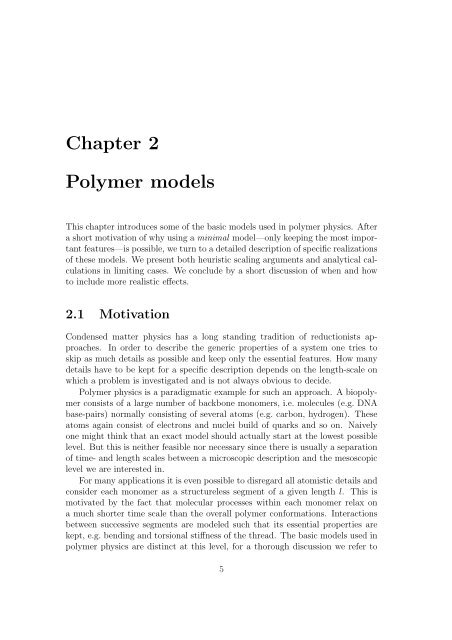Polymers in Confined Geometry.pdf
Polymers in Confined Geometry.pdf
Polymers in Confined Geometry.pdf
You also want an ePaper? Increase the reach of your titles
YUMPU automatically turns print PDFs into web optimized ePapers that Google loves.
Chapter 2<br />
Polymer models<br />
This chapter <strong>in</strong>troduces some of the basic models used <strong>in</strong> polymer physics. After<br />
a short motivation of why us<strong>in</strong>g a m<strong>in</strong>imal model—only keep<strong>in</strong>g the most important<br />
features—is possible, we turn to a detailed description of specific realizations<br />
of these models. We present both heuristic scal<strong>in</strong>g arguments and analytical calculations<br />
<strong>in</strong> limit<strong>in</strong>g cases. We conclude by a short discussion of when and how<br />
to <strong>in</strong>clude more realistic effects.<br />
2.1 Motivation<br />
Condensed matter physics has a long stand<strong>in</strong>g tradition of reductionists approaches.<br />
In order to describe the generic properties of a system one tries to<br />
skip as much details as possible and keep only the essential features. How many<br />
details have to be kept for a specific description depends on the length-scale on<br />
which a problem is <strong>in</strong>vestigated and is not always obvious to decide.<br />
Polymer physics is a paradigmatic example for such an approach. A biopolymer<br />
consists of a large number of backbone monomers, i.e. molecules (e.g. DNA<br />
base-pairs) normally consist<strong>in</strong>g of several atoms (e.g. carbon, hydrogen). These<br />
atoms aga<strong>in</strong> consist of electrons and nuclei build of quarks and so on. Naively<br />
one might th<strong>in</strong>k that an exact model should actually start at the lowest possible<br />
level. But this is neither feasible nor necessary s<strong>in</strong>ce there is usually a separation<br />
of time- and length scales between a microscopic description and the mesoscopic<br />
level we are <strong>in</strong>terested <strong>in</strong>.<br />
For many applications it is even possible to disregard all atomistic details and<br />
consider each monomer as a structureless segment of a given length l. This is<br />
motivated by the fact that molecular processes with<strong>in</strong> each monomer relax on<br />
a much shorter time scale than the overall polymer conformations. Interactions<br />
between successive segments are modeled such that its essential properties are<br />
kept, e.g. bend<strong>in</strong>g and torsional stiffness of the thread. The basic models used <strong>in</strong><br />
polymer physics are dist<strong>in</strong>ct at this level, for a thorough discussion we refer to<br />
5













